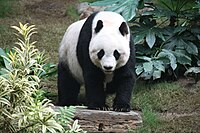
Photo from wikipedia
Abstract Since 2005, 12 captive pandas have been translocated into the wild. Of these, three were killed by conditional pathogen infections after release. Given that the gut microbiome is important… Click to show full abstract
Abstract Since 2005, 12 captive pandas have been translocated into the wild. Of these, three were killed by conditional pathogen infections after release. Given that the gut microbiome is important to host health and environmental adaptation, increasing the “wildness” of the gut microbiomes of captive pandas might improve translocation success. Here, we analyzed the long-term monitoring data (16S MISEQ data about 700 samples) of two wild giant panda populations (Xiaoxiangling and Minshan Mountains populations), five GPS-collared translocated giant pandas (TPs), and their living environment (dietary bamboos and soils) in the Liziping Reserve, China. We found that panda gut microbiome composition shifted dramatically after translocation: in the captive panda gut microbiome, Enterobacteriaceae dominated, while in the wild panda gut microbiome, Pseudomonadaceae dominated. More “wild” gut microbes were identified in the wild and semi-wild translocated panda guts than in the panda guts prior to release. However, under the current translocation strategy, the semi-wild stage lasts only 2–3 months, which might not be long enough to establish a stable “wild” gut microbial community. The observed changes in the translocated panda gut microbial communities (i.e., the proportional increase in Pseudomonadaceae abundance) and metagenomic function (i.e., the higher proportion of essential amino acid metabolic activity) might reflect a putative evolutionary adaptation to the local environment at the translocation site. We suggest that candidate pandas live with their mothers in a fenced area at the translocation site for an additional year prior to release. This is also more similar to the typical life cycle of the local wild giant pandas.
Journal Title: Global Ecology and Conservation
Year Published: 2019
Link to full text (if available)
Share on Social Media: Sign Up to like & get
recommendations!